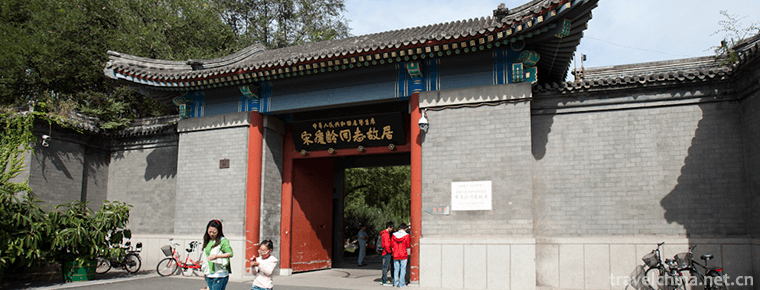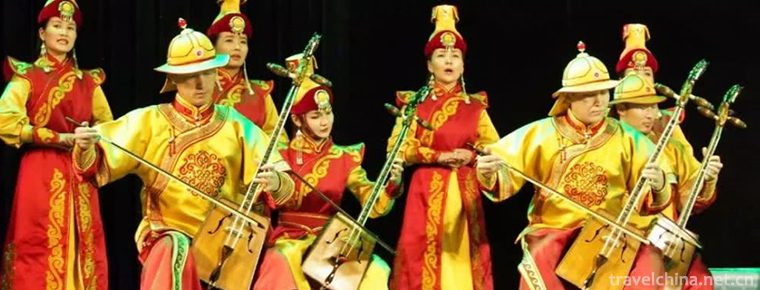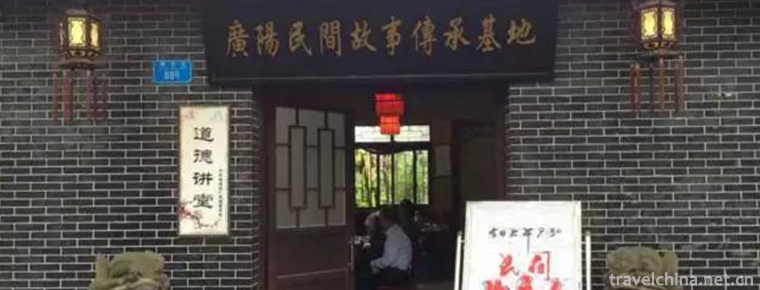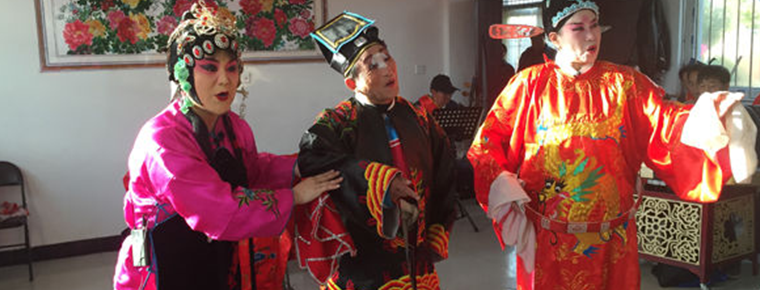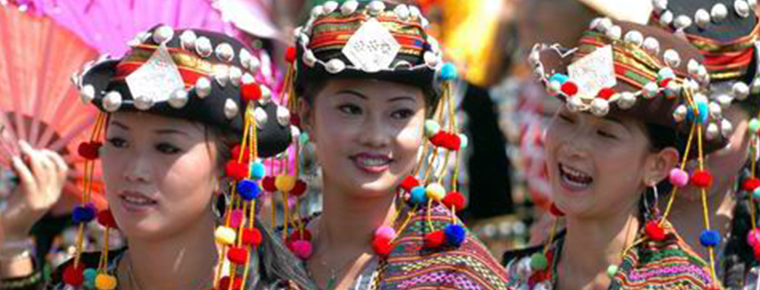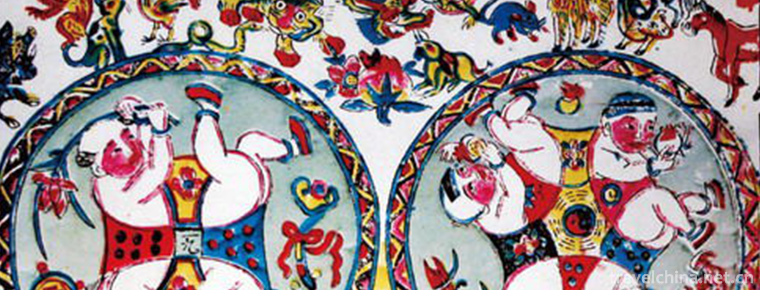Taoist Music
Taoist Music
Taoist music is one of Chinese religious music. Taoist music is an indispensable part of Taoist rituals. It has the characteristics of foiling and rendering religious atmosphere, enhancing believers'yearning for the immortal world and their respect for the immortals. Taoist music has absorbed the essence of ancient Chinese court music and traditional folk music, infiltrated into the characteristics of Taoist belief, formed the unique artistic style of Taoist music, and is also an important part of Chinese traditional music.
On June 7, 2008, Taoist music was approved by the State Council and listed in the second batch of national intangible cultural heritage list.
historical origin
Age of origin
Taoist music, also known as Dharma music and Taoist music, began in the Northern and Southern Dynasties (420-589). It is the music used in Taoist religious activities such as celebrating the birth of immortals, praying for heaven's blessings, demonizing and exorcising demons, and exceeding the dead. The earlier Taoist legal activities were the inheritance and development of the ancient ritual of sacrificing gods by witches. Initially, the chanting of sutras was direct, and there was no record of the use of music.
According to "Wei Shu Shi Lao Zhi", in the second year of Shenrui (415), Emperor of the Ming Dynasty of the Northern Wei Dynasty, Kou Qian was named the emperor of Songshan when he met Taishang Lao Jun, and granted him the title of heavenly teacher. He also enacted a new law of chanting and disciplining music in the clouds, which resulted in the initial rhymes of Taoist music such as "Ode to Huaxia" and "Xuci of Step".
The so-called "Ode to Huaxia" according to the annotation of "Yuyin Fa Shi", said: "Huaxia, 3500 miles for Huaxia, its far-reaching meaning, today Huaxia from the real hall, Xu Yin, through the corridor, the palace, and the end. It seems to take its far-reaching meaning. This is about a kind of rhyme chanted in the March before the opening of Taoist ritual altar.
"Buxu Ci" is mostly a eulogy of immortals, generally five-and seven-word poetry, regardless of length, depending on the needs of the law.
"Yuefu Ancient Titles to Explain" said: "Foot rhetoric, Taoist music is also." According to the book Yiyuan written by Liu Jingshu in the Southern Dynasty, "King Chen Siwang (Cao Zhi) travels to Yushan and suddenly hears the sound of chanting Sutras in the air. It is clear and bright, because it is written by the announcer for the voice of immortals, followed by Taoists and made empty noises." According to Chao Zhi, it reads: "Its chapters are all high immortals going to Yujing, the capital of the Holy pilgrimage, and flying through the void is satirized, so it is called step-empty." It is named for its rhyme like the voice of many immortals in empty chanting, and its style is ancient and elegant. Lu Xiujing, a Taoist monk in Maoshan in the Southern Dynasty, wrote "The Emperor of Xuanling Bao in Taishan Cave" and collected "The Word of Foot" in "Orthodox Dao Zang, Dong Xuanmu, Praise Class" and "Yuyin Fa Shi", which recorded many "The Word of Foot" in "The Word of Yuyin Fa Shi".
Heyday
Tang and Song Dynasties
The Tang Dynasty is one of the most prosperous periods of Taoist music development. The Taoist music in the Tang Dynasty was composed of simple percussion instruments such as bells, clocks and drums, adding blow and pluck instruments. Tang Gaozong once ordered the music workers in the palace to make tunes. Xuanzong had ordered Taoist priests and ministers to present Taoist music, and personally studied and taught Taoist music, which was used to perform in the Taiqing Palace when offering sacrifices to Lao Tzu.
"Mixed Yuan Sacred Records" Volume 8: "Xin Mao in February, the emperor's neon dress feather music, purple Wei Eight-Diagrams dance, to recommend the Taiqing Palace, is also different from the nine temples."
In Volume 54 of the Book of Turtles, the Emperor taught Taoist monks to walk in empty rhyme in April (Ten Years of Tianbao). He also ordered the Taoist priest Sima Chengzhen, Li Huiyuan's Xuanzhen Taoist Opera and Daluo Tianqu, the Minister of Imperial Work, He Zhizhang's Purple Qing Shangsheng Taoist Opera, the Imperial Ministry's waiter, to make Jingyun, Jiuzhen, Ziji, Chengtian, Shuntian Music and Xiaolongevity. Xuanzong wrote Taoist tunes such as "Song of Real Calling Immortals" and "Song of Ziwei Sending Immortals".
Tang poets also mentioned Taoism in their poems, such as Zhang Ji's sentence "but go to Yao altar to sleep, and listen to empty steps and empty voices"; Xue Tao, a female poet, in her poem "Trial of new clothes and initial production of tailoring", wrote "Changjian is the Shangqing ritual, once a group of immortals put Yuzhi in place; every time she goes to the palace singing and dancing, she bends down to sing empty words at the same time". It can be seen that Taoist music was popular at that time.
During the Tang Dynasty, Taoist music spread from the court to the Chinese folk because of the movement of Taoists, and absorbed many Chinese folk tunes, including some Buddhist music and Western music. Some of them were renamed as Taoist activities, such as Changhuan, Sulomi and Rising Sun, which included them in Taoist music.
Taoism in the Tang Dynasty was highly respected by emperors, and Taoist music was also valued. Gaozong had asked musicians to make Taoist tunes. Xuanzong not only ordered Taoist priests and ministers to make Taoist music, but also personally preached Taoist "rhyme of empty steps" in the court Taoist arena. Taoist music in the Tang Dynasty gradually developed and improved on the basis of absorbing Chinese folk music, Western Regions music and Buddhist music at that time. In the late Tang Dynasty, Zhang Ruohai wrote Xuantan Publication Errors, which called Taoist music of the Tang Dynasty "Guangchen Zayue, Bage Yu Dance, and I'll refer to them all." Du Guangting, a famous Taoist priest in the late Tang Dynasty and the Five Dynasties, compiled the Complete Works of Dao Men Ke Fan Da, which was a masterpiece of the previous Daoist religious rituals, and further standardized the rituals of Daoist religious rituals. At this time, the Dow music has been increased from simple percussion instruments such as bells, chimes and drums to blow and pluck instruments.
Song Dynasty is another important period for the development of Taoist music. Taoist music in Song Dynasty has the style of Nanqu, and silk string music has joined the ranks of Taoist music. Song Taizong, Song Zhenzong and Song Huizong compiled several dozen pieces of Taoist music respectively, such as Buxu Ci, Sanhua Ci, Baihe Zan, Yuqing Yue and Taiqing Yue. In particular, the good Tao of Huizong in the Song Dynasty reused Lin Lingsu, a Taoist priest, to modify and supplement the ritual of Taoist Zhaibao, to issue 426 "Golden Seal Lingbao Taoist Court Etiquette" and to select Taoist priests from all over the country to study Taoist music in Beijing. The earliest collection of Taoist music in China, Yuyin Fa Shi, was compiled in the Northern Song Dynasty. It recorded 50 poems of Ci since the Northern and Southern Dynasties, Sui and Tang Dynasties and praises made by Song Zhenzong and Song Huizong. Curve notation is called "song twists and turns" in "Han Shu Yi Wen Zhi". It is like singing three sighs, with many linings, and has the style of Nanqu. Silk strings have joined the ranks of Taoist music, and the accompaniment instruments of Taoist music are becoming more and more complete.
Yuan Ming
By the Yuan Dynasty, there were two major Taoist schools, Quanzhen and Zhengyi, and two different styles of Taoist music appeared. Quanzhen pays great attention to the Qing Dynasty, and its music is more pure and quiet, while Zhengyi Zhai Di and Fu Zhuan are vigorous and elegant.
In the early Ming Dynasty, Zhu Yuanzhang set up the Xuanjiao Academy to administer Taoism throughout the country (later Xuanjiao Academy was renamed Daoist Records Department). He ordered Taoism to be cleaned up and ordered Taoists to compile ritual models of Zhaijian, which gradually standardized Daoist music. In the eleventh year of Hongwu in Ming Dynasty (1380), he built "God Optimism". He was subordinate to Taichang Temple. He was in charge of court sacrificial activities and music and dance students. He was led by Taoist priests who were proficient in music and dance. Music and dance students were recruited by Taoist children, such as Quanzhen Taoist priests. In addition to the Beijing Master, there are also music and dance students in Wuyue for the national sacrifice. In the early Ming Dynasty, the famous Taoist priest Lengqian once advocated "God is optimistic" and "Dingyale". In the fifteenth year of Hongwu (1382), Zhu Yuanzhang personally decided on Taoist textbooks and musical instruments, and in Yongle (1403-1424), Zhu Ding, the founder of Chengzu, made the Daming Xuanjiao Movement. He wrote the music with the method of "Gongru". There were three parts: Yantan chanting movement, Xuantian Emperor movement and Hong Enling Jizhenjun movement. The repertoire included Yingfeng Jian, Tianyue, Shenxian Ji, Yingxian Gu, Bugao and other 14 pieces. Later, he earned the Orthodox Taoist Collection, which is a valuable material for the study of ancient music in Ming Dynasty.
the Qing dynasty
The management of Taoist music in Qing Dynasty basically followed the old system of Ming Dynasty. Dongyue Temple, Pantao Palace, Lv Zu Temple, Yue Temple and Guan Temple in Beijing are all "God optimistic". They live in music and dance, wear Taoist costumes and store hair in temples, but there are families and father and son hereditary. When there is a royal festival, the imperial palace will take part in the ceremony. The music played by the court is a kind of sacrificial music, which uses more musical instruments and is magnificent and joyful. In the folk, Daoist music and local tunes are widely integrated, forming different styles of Daoist music in different places. Taoist music has embarked on the road of diversification, regionalization and secularization.
Document record
There are few Taoist music materials in the early Taoist rituals. Kou Qian's intonation in the clouds in the second year of Shenrui (415), Emperor of the Ming and Yuan Dynasties in the Northern Wei Dynasty, namely "Huaxia Song" and "Buxu Sound", is an early written record of Taoist music. By the Northern Song Dynasty, the compilation Yuyin Fa Shi, a collection of Taoist music, was produced, in which 50 pieces of Taoist music were recorded from the Tang Dynasty to the Song Dynasty. This is the earliest vocal music compilation of Taoist music that can be seen at present (the existing version of Dao Zang in the Ming Dynasty is lost in the Song Dynasty). However, the method of curve notation has not yet been able to translate its tone. In the Southern Song Dynasty, Taoist music was widely spread among Chinese people. According to Volume 57 of "Wu Shang Huang_Da Zhai Li Cheng Yi", Taoist music at that time paid more attention to the use of vocal and instrumental forms. Taoist music in the Ming Dynasty entered the finalization period because of the simplicity, standardization and unification of Taoist rituals in Hongwu 7 years (1374), and new development. The Taoist Music Anthology Daming Imperial Xuanjiao Movement, which appeared at this time, recorded 14 Taoist tunes by the traditional Gongru notation method. In the Southern Song Dynasty, Taoist music was widely spread among Chinese people. Taoist music in Ming Dynasty not only inherited the old music of Tang, Song and Yuan dynasties, but also absorbed the new Taoist music of Southern and Northern Opera. Even Chinese folk music such as Qingjiang Xing, Changdihua, tea-picking songs and other tunes were absorbed by Taoist music, which became more standardized and unified, and entered a finalized period. Modern Taoist music basically inherited the traditions of the Ming Dynasty. According to the records of Taoist music in Daming Xuanjiao Li Cheng Zhai Yi, Daming Imperial Xuanjiao Movement and Notre Dame Peacock Ming Wang Jing, Taoist music in Ming Dynasty not only inherited the old music of Tang, Song and Yuan Dynasty, but also absorbed the new Taoist music of North and South, even Chinese folk music such as "Qingjiang Yin", "Bingjin" and "Tea Picking Song" are Taoist tunes. Happy to absorb. In Volume 9 of Ye Mengzhu's edition of Reading the World in the early Qing Dynasty, it was said that Taoist legal acts "quoting merchants to carve feathers, combining music with Sheng songs, unexpectedly have the same excellent opera".
In terms of music score, in addition to the two kinds of music in Orthodox Taoist Collection, Cao Xisheng, a Taoist priest in Suzhou, published the music collected and sorted by Wuding'an in the fourth year of Jiaqing (1799) of the Qing Dynasty as Juntian Miaoyue (divided into three volumes), Ancient Rhyme Formulated Rules and Neon Dress Elegant Rhyme. Taoists in the south of the Yangtze River call it Cao Pei.

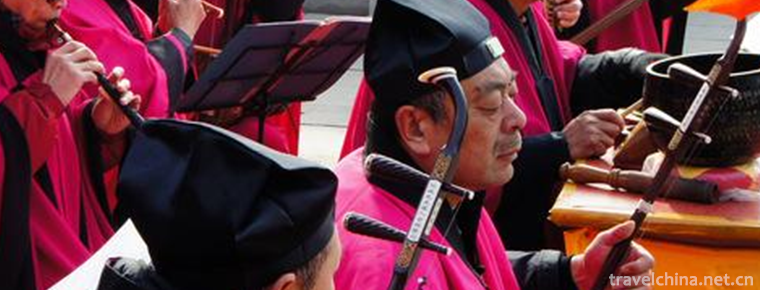
-
Donkey HamBurger
Donkey HamBurger is a popular traditional snack in North China. It originated in Baoding. Widely spread in the central Hebei Plain, the brine good donkey meat adds the old soup to join the crispy fire.
Views: 211 Time 2018-11-07 -
Red Beach Scenic Area
Red Beach Scenic Spot is a national 4A class scenic spot and an excellent scenic spot in Liaoning Province. Located in Zhaohuanhe Township, Dawa County, Panjin City, Liaoning Province.
Views: 161 Time 2019-01-16 -
Memorial of Song Qinglings Former Residence in Shanghai
Song Qingling's former residence in Shanghai is the place where Song Qingling lived and lived for a long time. Qingling came to live here in the spring of 1949 and ushered in the liberation of Shangha.
Views: 154 Time 2019-02-13 -
Legend of Anima Qingxueshan
The Legend of Anima Qing Snow Mountain refers to the legendary Anima Qing Mountain God, who is a powerful and upright God riding a high-headed white horse, holding a Mani bag (a treasure)..
Views: 186 Time 2019-03-28 -
Asil Lysi
"Asr" is the abbreviation of "Asru Winder" in Mongolian, and its translation is of great significance. Asr is a kind of Mongolian court music, which has a unique national style and.
Views: 217 Time 2019-03-28 -
Folk Stories in Guangyang Town
"Guangyang Folk Stories" is the general name of folklores and stories widely spread in Guangyang Town. Guangyang folk tales are popular in the local area..
Views: 188 Time 2019-05-01 -
Haicheng Hornplay
Haicheng trumpet opera, the local traditional drama of Anshan City, Liaoning Province, is one of the national intangible cultural heritage..
Views: 344 Time 2019-05-02 -
Nau Song of Jingpo Ethnic Group
The Jingpo Munao Longitudinal Song is the most solemn traditional national festival of the Jingpo nationality and one of the national intangible cultural heritages..
Views: 79 Time 2019-05-08 -
Wuqiang Wood Engraving New Year Picture
Wuqiang New Year's Painting is one of the traditional folk crafts in Wuqiang County, Hebei Province. It is named for its origin in Wuqiang County, Hebei Province. It is a unique style of Chinese folk .
Views: 100 Time 2019-06-30 -
Jianshan natural scenic spot
Jianshan scenic spot, located in the west gate of Zigong, Yandu city and rongbian town of Ziliujing District, is a provincial-level natural scenic area in Sichuan Province. .
Views: 349 Time 2020-10-15 -
Hydrology in Luzhou
There are many large, medium and small rivers in Luzhou, but the runoff of small streams is short. The rivers in the territory belong to the Yangtze River system, with the Yangtze River as the main trunk, distributed in a tree shape, and flow into the Yangtze River from south to North.
Views: 377 Time 2020-12-14 -
Luzhou economy
In 2019, the GDP of Luzhou will reach 208.13 billion yuan, an increase of 8.0% over the previous year, 1.9 percentage points higher than the national average level (6.1%) and 0.5 percentage points higher than the provincial average level (7.5%). Among them, the added value.
Views: 340 Time 2020-12-14


